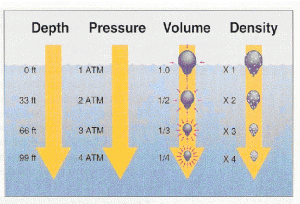Air was a topic that I had wanted to write about for some time now as it seemed to be the common theme when discussing buoyancy, equalization, air consumption, safety and more; but, as I started writing I kept branching out on the topic and ended up with a super long blog! Soon I realized and quickly decided that my topic had evolved into a 5 part series! So, I am excited to present this blog as the introduction piece to this series and the topic that I am going to zero in on is all about Air and the impact that the underwater world has on that; Afterwards, I will go into more detail on 5 more specific areas of diving that all have important relationships with Air: the BCD, our Ears, our Mask, the Tank & Octopus, and finally our Lungs & Breathing.
Some of the ins and outs of diving and air include a wee bit of background knowledge of a basic scientific principle. Considering science and math have never held my interest for too long, I remember over 10 years ago when I did my Open Water training, I really brushed over these topics with a passing score yet not fully understanding the key concepts. Now that I am an Instructor I see students struggling in the same way I did and I hope that I can offer some advice I wish an Instructor could have provided me earlier on!
So here goes for my little scientific introduction to air and diving…
As we all know, water has weight (when you pick up a bucket of water – it’s heavy!). That means, when you go underwater there is a lot of weight on you; this is otherwise known as “Pressure”. We are lucky though because the weight of water doesn’t have any effect on similarly composed liquids like the makeup of our body, so we can swim freely below the surface without feeling the weight of water on our bodies. However, this weight does affect “Air Spaces”. Air is made up of many molecules that are spread out all around us on the surface. Underwater, air can be found inside our Buoyancy Control Devices (BCD), in our ear and sinus spaces, inside the mask, and in our lungs (of course!). As you go underwater, the air molecules will get closer and closer together in each of these areas (air becomes “Dense”).
If you look at the Density arrow in the picture below, you will see that on the surface, Air Density = 1x and at 30m/99ft, Air Density = 4x. That means, for example, that if you compare a breath you take on the surface to a breath you take at 30m/99ft, you would, in fact, be taking in 4x the amount of air you would breathe on the surface. In addition, consider that as you ascend from your dive, that air becomes less dense and will naturally expand in the air spaces found in your BCD, ears/sinuses, mask, and even your lungs if you hold your breath! It is quite a simple principle that is very helpful (and extremely important!) for you to practice fun, enjoyable and safe diving experiences.
Click here to read my next blog which will be about how Air and your BCD interact, including tips and equipment recommendations from DiveWithMia!





